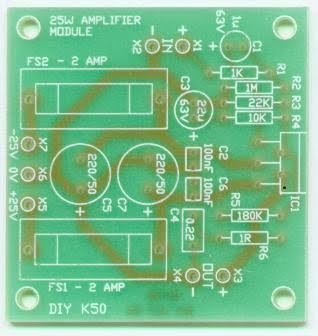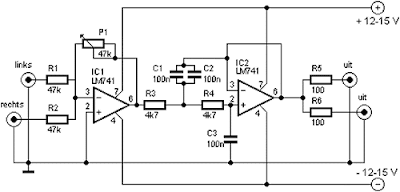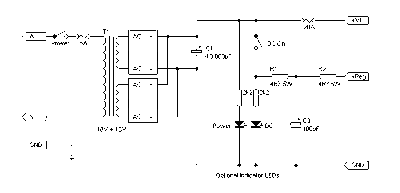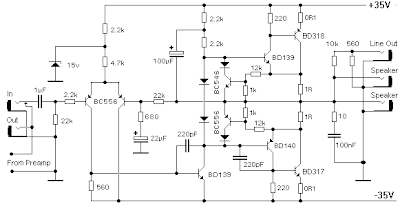
Electronic project contains the essential elements for building a HiFi Amp module using the LM1875 chip.
This project contains the essential elements needed to build an amplifier module for high fidelity with the National Semiconductor LM1875 IC. With the addition of a handful of parts and an adequate supply, this module provides 25W RMS into 8 ohms @ 1% THD.
PCB dimensions are a tiny 53 x 50mm (2.1 “x 2″). Heatsink, power transformer, speaker and cables are not included. (CPS50)
This project contains the essential elements needed to build an amplifier module for high fidelity with the National Semiconductor LM1875 IC. With the addition of a handful of parts and an adequate supply, this module provides 25W RMS into 8 ohms @ 1% THD.
The project is built on a single side PCB. Protel Schematic & Autotrax were used in conception.
25 Watt LM1875 Implementation of components containing PCBs
Data to be provided to you:
Heat sink with a thermal resistance of 1.4 C / W or higher. Use the washing of silicon impregnated in the event of attack on the chip.
Speaker 8 ohm adequate power
Suitable cables.
Solder the power cables and audio directly on the pad provided on the PCB.
The chip can be used with two agreements that provide single and dual power. We decided to use the dual fuel version. Version only offering that require the use of electrolytic capacitors 63V, thus increasing the cost and overall size of the module.
The input signal is coupled with R1 and C1 for the non-inverting input (pin 1) of the integrated circuit. Closed-loop gain of the amplifier is set at 19 by resistors (180K) and (10K). and C (22uF) in 3dB frequency point 7Hz.
The output appears on pin 4 of IC and drives a speaker directly. Speakers can produce long enough capacity to drive the amplifiers in the VHF oscillation. Resistance R6 (1W) and capacitor C4 (0.22UF) to help prevent this. They are linked through the production and the form of a Zobel network, which provides high frequency stability when driving capacitive loads.
The power supply integrated circuit is connected via 2A fuse for protection against external shorts to ground. Provide additional decoupling capacitors Supply Board.
The module is powered by a dual + / – 25V supply. These guides are provided by a separate power supply board. Consists of four diodes (1N5401) connected as a rectifier bridge and four electrolytic capacitors (2200uF) to soften wrinkles.
The power transformer used to power the module should be assessed at 60VA with a center-operated 35V secondary winding. A 30V transformer secondary winding can also be used, but the lower output DC would lead to reduced power.
If you want to run two modules in a stereo amplifier, you can use a common food. In this case, the RANSFORMER should be valued at 80VA.
Test
Before the switch, verify that all parts are inserted in the correct positions. Make sure that the electrolytic capacitors are in the right direction. Connect the power leads with a multimeter (set to read amps) in series with the positive rail. Do not connect a speaker or an audio input yet.
Turn on and check the current stabilizes at 50-70mA. There will be a brief charges that Suge main filter capacitor. You must have installed the radiator, otherwise the overload protection circuit to reduce the heat in and out.
If the quiescent current is correct, check the DC offset voltage at the terminals of the speakers. It must be less than + / – 50mV. If all goes well, switch off the device and connect a speaker and an audio signal input.

25Watt Hifi Amplifier PCB






















